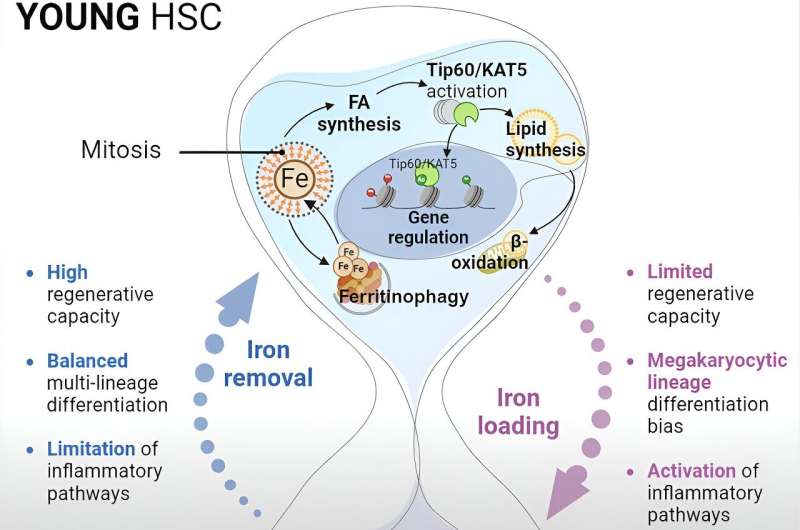This article has been reviewed according to Science X's editorial process and policies. Editors have highlighted the following attributes while ensuring the content's credibility:
fact-checked
peer-reviewed publication
trusted source
proofread
Iron restriction keeps blood stem cells young, researchers find

As we age, our hematopoietic (blood-forming) stem cells (HSCs) become less able to produce new red and white blood cells and other vital blood components—contributing to chronic inflammation and accelerating the onset of blood cancers and degenerative diseases.
Researchers at Albert Einstein College of Medicine and the National Cancer Institute-designated Montefiore Einstein Comprehensive Cancer Center (MECCC) have found that failing HSC function can be prevented or even reversed by reducing iron levels in these adult stem cells. The findings are published in the journal Cell Stem Cell.
"We've shown that this decline in HSC function is not inevitable and appears to be reversible," said study senior and co-corresponding author Britta Will, Ph.D., associate professor of oncology, of medicine, of cell biology, and the Belfer Scholar in Cancer Research at Einstein, and co-leader of the stem cell & cancer biology program at MECCC.
"By lowering iron levels inside the cell with a clinically available drug, we were able to restore a youthful pool of HSCs in older mice. This simple treatment strategy holds promise for slowing aging-related diseases as well as chronic inflammatory diseases and blood cancers."
An unexpected role for iron in blood stem cells
This research dates to 2018, when Dr. Will and colleagues observed that eltrombopag, a drug used to boost levels of platelet blood cells, also stimulates the activity of HSCs. At that time, the researchers discovered that this improvement occurs because eltrombopag removes, or chelates, iron from HSCs. Their new study showed that the amount of iron inside HSCs determines the cells' fate and function.
After analyzing HSCs, the researchers found that excess intracellular iron activates inflammation within HSCs and pushes them towards dormancy—a state in which a cell's functions are massively slowed, similar to animal hibernation. Dormancy limits HSCs' ability to make more copies of themselves and to produce sufficient numbers of high-quality blood cells. Conversely, HSCs with restricted iron levels readily multiply and respond effectively when more blood components are needed.
"So basically, iron restriction governs and protects the regenerative capacity of stem cells—their ability to divide and to differentiate into blood cells," said the paper's co-corresponding author Yun-Ruei Kao, Ph.D., research assistant professor of oncology and of medicine at Einstein.
By what mechanism does iron limitation maintain HSC health? In studies involving young mice, the researchers found that low iron triggers a molecular response in HSCs that temporarily increases fatty acid metabolism, strengthening genetic programs in HSCs after they've proliferated in young animals. By contrast, HSC in aged mice were found to contain increased iron levels that inhibited the activation of this newly discovered fatty-acid metabolism pathway.
The researchers next studied whether removing iron from HSCs would improve blood-cell production in old and aging mice. To reduce iron levels in HSCs, the team injected old mice with the iron chelator deferoxamine daily for 14 days.
Compared with controls, aged HSCs exposed to iron chelation produced significantly more blood cells after their HSCs were transplanted into other mice. Longer-term iron chelation had an even more pronounced effect: When 6-month-old (middle-aged) mice were given an iron chelator for 13 additional months (well into old age), the animals' HSCs showed up to a 10-fold increase in regenerative capacity compared with controls.
Aging and iron intake
Since aging is widely associated with systemic iron deficiency, doctors often advise seniors to take iron supplements or eat more iron-rich foods. This supplemental iron lowers the risk of iron deficiency anemia, the source of numerous health issues. Those recommendations still hold, Dr. Will said. She noted that iron metabolism can deteriorate during aging, leading to iron deficiency in some organs and iron loading in others, including in the bone marrow where many HSCs are located.
"Our study's key finding—that chelators, by neutralizing iron loading inside HSCs, may enable HSCs to remain healthy into old age—is potentially important," said Dr. Will. "To our knowledge, this is the first time that a non-invasive strategy has successfully rejuvenated stem cells. But like all experimental strategies, it needs to be assessed in a clinical setting to make sure it's safe and effective."
Dr. Will is currently exploring HSCs and iron from several angles: how to safely limit iron in HSCs during aging; whether restricting iron levels within HSCs can prevent their aging-associated transformation into cancerous HSCs; and to what extent other adult stem cells, such as those in the gut, depend on iron restriction to reliably regenerate tissues and organs.
More information: Yun-Ruei Kao et al, An iron rheostat controls hematopoietic stem cell fate, Cell Stem Cell (2024). DOI: 10.1016/j.stem.2024.01.011
Journal information: Cell Stem Cell
Provided by Albert Einstein College of Medicine



















